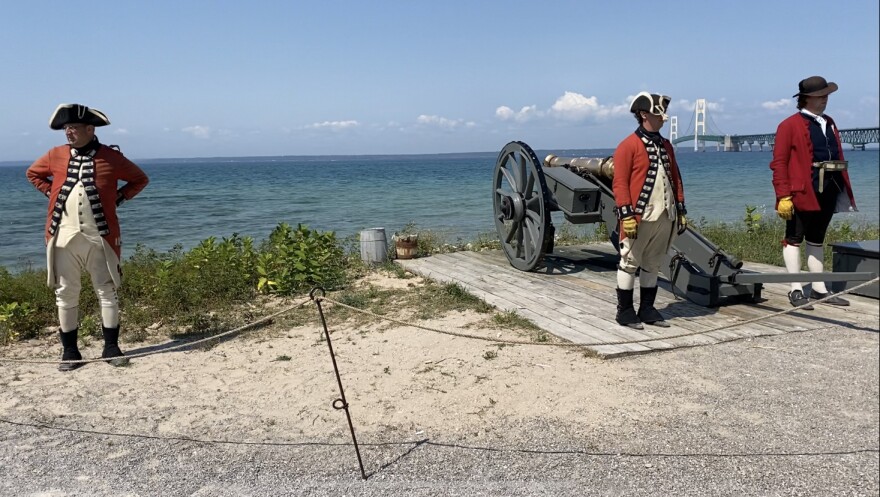The fort walls of Colonial Michilimackinac are large enough that they’re clearly visible from the Mackinac Bridge.
The gates are open– allowing visitors to enter through a dark passage to get inside the former military fort.
There are 18th century themed wooden buildings. People in clothing from the 1700s work on the grounds and give presentations to visitors.
Near the center, next to a row of houses, there’s an active archaeological dig. It looks like a construction site. A grid made of string breaks the site into smaller squares so the archaeologists can easily document their work.
Two archaeologists work intently: one carefully brushes the ground in search of something interesting.
Lynn Evans, the curator of archeology, is on the other side of the dig answering visitors' questions.
“So in the center there, we go down until we hit the rocky sandy beach,” she says “That's 3 or 4 feet normally, but in this house there's two root cellars and so anywhere from 4 to 7 feet.”

The second root cellar has offered a wealth of knowledge about the British fur trader who lived there.
“This is indicating that there's so much stuff here, that he needed more space,” says Evans.
And he left a lot behind.
“We find that he had very fancy ceramics,”she says, “Things that were being invented in the 1770s.”
The reenactment village of Colonial Michilimackinac is set in 1778. It portrays the lives of fur traders and soldiers. Archeological data helps re-create the world for visitors.
“It's like a giant puzzle, and we put all the pieces together, and is it perfect? ... I’m sure there's things we don’t have quite right, but I think it's pretty good,” says Evans.
Putting together the historical puzzle through archaeology can take a long time.
“You only get one chance,” she says. “As you dig up a site, you destroy it.”
The fur traders home that Evans and her team are currently excavating has been an active site every summer since 2008.
“It’s by far the longest we’ve ever spent on a particular project,” she explains, “The house before this took 10. The house before that took nine.”
Archaeology includes meticulously removing dirt and passing it through screens to find small items. On this project, they can use water to push through sand and other debris.
“We are able to waterscreen all of our deposits,” Evans says. “If we were on a construction site and we had a finite amount of time, we would have to make choices that we don’t have to make here.”
Archeology also includes writing down everything.
“You need to document it, and document it carefully because you can’t go back,” she says. “Once you’ve excavated it, that information is gone.”
That’s everything from fishbones to soil composition and whatever else is in between.
Visitor Rick Myers says watching the dig change is part of what has made his family come back over the years. Their last visit was about 7 years ago, when the site looked a little different.
“It was not quite as deep and not as many squares were filled in,” Myers says.
A cannon demonstration takes place at Colonial Michilimackinac everyday at 3 o’clock. It’s led by Patrick Chargo. It’s a six pound bronze light fieldpiece.

Chargo explains how the cannon works while two other men load the ammunition.
“Make ready!” he orders, “Fire!”
The reenactment suddenly comes alive with the sound of the blast. The audience gasps and claps at the explosion.
“And there's the salute welcoming you to Colonial Michilimackinac!” Chargo exclaims.

Archaeologist Lynn Evans says the past can feel like a foreign country, but with reenactments like this, for a brief moment, we can step back in time.


